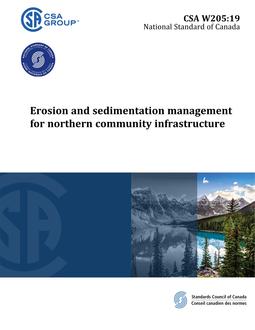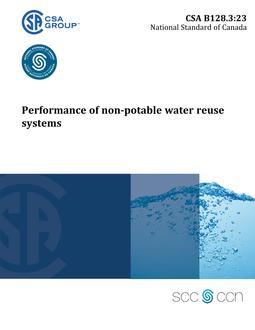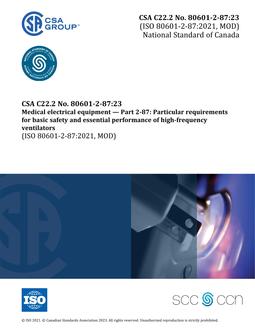
CSA W205:19
Click here to purchase
Preface:
This is the first edition of CSA W205, Erosion and sedimentation management for northern community infrastructure.
This Standard draws on industry expertise and best practices in Canada and internationally to address requirements for managing erosion and sedimentation risks in coastal and lakeshore environments, open-channel environments, and terrestrial environments.
Users of this Standard are reminded that additional and site-specific requirements could be specified by federal, territorial or provincial, regional, municipal, or other authorities or agencies, or by an owner. This Standard should not be considered a replacement for the requirements contained in any
a) applicable federal, territorial, or provincial statute;
b) regulation, license, or permit issued pursuant to an applicable statute; or
c) contract that an owner has with a contractor.
CSA Group acknowledges that the development of this Standard was made possible, in part, by the financial support of Standards Council of Canada, as part of the Northern Infrastructure Standardization Initiative.
This standard has been developed in compliance with Standards Council of Canada requirements for National Standards of Canada. It has been published as a National Standard of Canada by CSA Group.
Scope:
1.1 General
This Standard applies to the management of erosion and sedimentation risks, including the evaluation, planning, design, implementation, monitoring, and maintenance of erosion and sedimentation risk management strategies and mitigation measures for new and existing infrastructure in northern communities. This Standard provides
a) an outline of procedures for conducting an overall risk assessment, including infrastructure vulnerability;
b) factors related to erosion and sedimentation to be considered in land use and infrastructure planning;
c) an overview of the typical drivers of erosion and sedimentation hazards to which this Standard is applicable;
d) the procedures to be applied and erosion protection measures to be considered in three primary environments:
i) coastal and lakeshore;
ii) open channel; and
iii) terrestrial.
e) a discussion of specific steps taken to evaluate and address erosion and sedimentation risks:
i) site-specific evaluation and risk assessment;
ii) planning and design; and
iii) structural measures.
f) best practices for managing erosion and sedimentation;
g) procedures for inspecting, monitoring, and maintaining erosion and sedimentation mitigation measures;
h) discussion on incorporating adaptive management;
i) roles and responsibilities of personnel organizing or supervising the installation, inspection, monitoring, and maintenance of erosion and sedimentation mitigations;
j) emergency response and contingency planning protocols for addressing failures or imminent failures in erosion and sedimentation mitigations implemented to protect infrastructure and the environment;
k) a framework for community-based processes for addressing erosion and sedimentation, and impacts to infrastructure; and
l) background information and relevant reference material.
Compliance with this Standard will allow users to demonstrate that the design and implementation of erosion and sedimentation risk management strategies and mitigation measures take into consideration, and are compatible with, the mitigations that may be required to preserve permafrost or reduce the disruptive effects of permafrost thaw. Because the performance of permafrost is often integral to the success of erosion and sedimentation risk management strategies, compliance with this Standard will help mitigate impacts to both onsite infrastructure, and the environment and infrastructure surrounding the project site.
1.2 Users
This Standard is intended for use by the following:
a) the owners and operators of buildings, structures, transportation or utility networks and facilities, hydro dams, or other infrastructure that can be affected by erosion and sedimentation;
b) the owners and operators of other community infrastructure (e.g., drainage systems) for which the mitigation of erosion and sedimentation is important;
c) contract administrators who oversee a project with erosion and sedimentation risk management or mitigation components;
d) site investigators (scientists and engineers) who evaluate the site conditions (existing and projected) and estimate the risks related to erosion and sedimentation;
e) design professionals and reviewers (consulting engineers, architects, and territorial or regional technical services staff) who design, assess and approve, and oversee the implementation of engineering-based interventions;
f) contractors who implement engineering-based interventions;
g) regulatory authorities, such as land and water boards and review boards;
h) compliance authorities, such as qualified building inspectors and qualified environmental inspectors;
i) land use planners and community planning officials;
j) educators, for the purposes of knowledge transfer; and
k) others with a vested interest in erosion and sedimentation risk management or mitigative elements of infrastructure planning and/or construction projects, design and construction of adaptations and structures to mitigate or respond to erosion and sedimentation, and inspection of erosion and sedimentation control or mitigation measures and plan implementation.
1.3 Application
1.3.1 General
The requirements provided in this Standard are intended to address erosion and sedimentation risks to
a) existing or newly proposed community infrastructure, which might be exposed to erosion and sedimentation hazards under present-day or future conditions; and
b) the environment, as a result of infrastructure projects that cause disturbances to soil, including excavations, vegetation/topsoil removal and grading, and development-related activities that could impact an environmental feature including a coastal or inland shoreline, watercourse, wetland, forest, etc.
This Standard also applies where erosion and sedimentation risk management measures are required by contract, permit, regulation, or other approval. The application of the Standard begins with the overall risk assessment and evaluation of infrastructure vulnerability phases of a project. The application of the Standard continues throughout the lifespan of the infrastructure project or strategic planning cycles, including site preparation, construction, operation and maintenance, and decommissioning, or until residual risk levels are deemed acceptable.
1.3.2 Types of infrastructure
This Standard applies to the evaluation, planning and design, implementation, as well as monitoring and maintenance of erosion and sedimentation mitigation measures during all phases of construction, service life and decommissioning of
a) buildings or additions to buildings (subdivisions or individual buildings including housing, commercial or community centres, offices, schools, etc.);
b) infrastructure (roads, bridges, culverts, dams, hydraulic structures, utilities, sewers and watermains, landfills, sewage treatment facilities, piers, wharfs, breakwaters, shore protection, bank/slope stabilization, etc.);
c) natural resources extraction infrastructure and operations (e.g., mining, drilling);
d) farming infrastructure and operations; and
e) expansions of any of these types of facilities or structures.
Notes:
1) Though natural resources extraction infrastructure and operations would not ordinarily be considered “community”-related, this Standard is intended to apply to any infrastructure or operation that can affect a community. For example, if a dredging operation for an artificial drilling island has the potential to cause sediment to be washed up onto a community shoreline, or to result in the loss of material that could contribute to the retrogression of a shoreline, this Standard would apply.
2) Similarly, farming operations might have the potential to create dust in the adjacent community, or a change in water quality downstream of the farm due to potential sediment-laden runoff to a stream.
3) For cases in which erosion and sedimentation from such infrastructure or operations do not directly affect a community, this Standard might be implemented in order to protect other elements in the environment.
1.4 Terminology
In this Standard, “shall” is used to express a requirement, i.e., a provision that the user is obliged to satisfy in order to comply with the Standard; “should” is used to express a recommendation or that which is advised but not required; and “may” is used to express an option or that which is permissible within the limits of the Standard. Notes accompanying clauses do not include requirements or alternative requirements; the purpose of a note accompanying a clause is to separate from the text explanatory or informative material. Notes to tables and figures are considered part of the table or figure and may be written as requirements. Annexes are designated normative (mandatory) or informative (non-mandatory) to define their application.
Product Details
- Edition:
- 1st
- Published:
- 11/01/2019
- ISBN(s):
- 9781488323683
- Number of Pages:
- 102
- File Size:
- 1 file , 18 MB
- Product Code(s):
- 2427431, 2427433, 2427431


